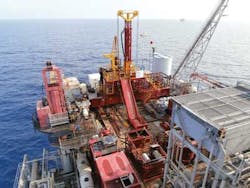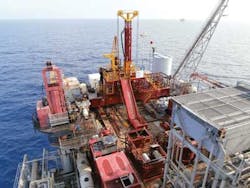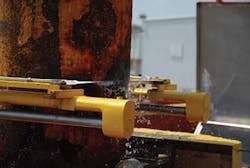Integrated approach enhances conductor removal efficiency
P&A in maturing wells becoming a growing priority
Cham Soon Hoe
Weatherford
As an integral and critical component of well P&A, conductor removal requires efficiency and safety in order to ensure operating companies comply with increasing regulations and maintain environmental stewardship. Globally, Weatherford estimates 20,000 idle offshore wells are currently in need of P&A services, which account for around 43% of total well abandonment costs. The spend globally for decommissioning over the next 20-year period is estimated at $400 billion, the percentage of that associated with well abandonment and pre abandonment intervention is estimated at circa 40%.
Regulations require that wells must be abandoned when they have matured and are no longer productive due to depletion or damage, or cannot be revitalized cost-effectively. In some regions, governing bodies will not issue new permits to an operator until the company's idle wells are formally abandoned.
In theGulf of Mexico, if a well has not been productive for three or more years, the operating company must develop an abandonment plan specifying a timeframe and methodology for the process. The maturing North Sea sector is also highly regulated when it comes to well abandonment. Stricter regulations are being developed for the Asia/Pacific region, where a large number of old wells are now candidates for P&A, the overwhelming majority of them on platform wells.
For service companies, P&A operations require thorough planning and operational excellence. Projects must be carried out in an efficient, safe, and in an environmentally-responsible way while complying with regulatory framework that varies from region to region.
In response to this growing market, Weatherford has developed a portfolio of services designed to facilitate single-source well P&A operations, including conductor removal from multi-well and single-jack platforms and mono-wells. In June 2014, the company completed a four-well conductor removal project for a major operator in Brunei, successfully recovering 24 joints and a total of 1,129 ft (60 m) of pipe in just over 100 hours.
The suite of services used for the operation provided a one-time solution, minimizing overall costs related to non-productive time (NPT) and additional remediation that can result from poorly-planned and executed projects. Safety was enhanced by using equipment that mitigated the risk of lifting and eliminated manual handling and gas torch/hot work issues.
Conductor removal
Removal of the conductor, the outer pipe casing that houses the internal casing string, can be facilitated with an existing rig at the well site, or by using a rigless solution with a light-duty pulling and jacking unit. If executed properly, conductor removal also provides a secondary benefit of facilitating slot recovery on multi-well platforms. After the conductor is removed below the mudline, the operator can install a conductor-type whipstock and drill a new well in the same platform, taking advantage of the existing infrastructure.
As the abandonment portion of a well abandonment project, conductor removal is essential, and requires a full suite of complementary tools and technologies. The conductor is typically run about 200 ft (61 m) below the mud line from an offshore platform, and its assembly consists of one or more strings cemented together. In a well P&A project, after the reservoir's production zone is successfully plugged to prevent any hydrocarbons from leaking back to the surface, conductors are abandoned, or removed, to a point 3 m to 5 m (10 ft to 16 ft) below the mudline in order to leave a flat, clear ocean floor surface. Operational complexity varies depending on the water depth, total weight, and number of strings.
The Weatherford conductor removal technology family includes boring, pinning, sawing, and lifting systems to remove multiple subsea casing strings safely and quickly. A four-unit conductor cleaning system eliminates the exterior casing of any marine growth. After the initial cuts to the external and internal multi-string casing, the system bores holes through the strings, enabling the installation of pins through the holes. This process also provides a lifting mechanism that binds and secures the group of strings together. The secured strings are lifted by blocks or casing jacks with no slippage. Depending on the weight, length and the ability to pull and lay down each section of casing safely, a predetermined length is for each section is cut.
An external reciprocating saw cuts 2-in. to 32-in. pipe to enable sectioning of most material or grade. The saw provides fully-automated clamping, cutting feed, and cutting speed capabilities that allow the operator to maintain cutting consistency and control remotely. All moving parts are equipped with guards.
Displaying 1/2 Page 1,2Next>
View Article as Single page


